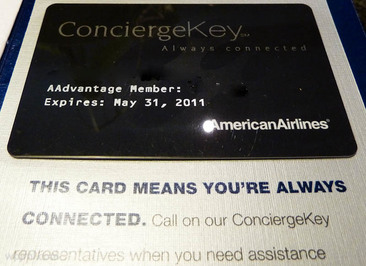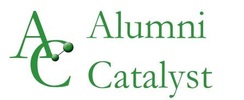
The movie Up In The Air came out in 2009, with a sub-plotline about a business traveler’s quest to achieve status as a member of the unadvertised, little known, American Airlines Concierge Key program. While most of us are busy trying to figure out how to get an extra bag of pretzels on our flights, there are a select few business travelers who are in the air so much that the airlines cater to them to make sure that every part of their trip goes perfectly. That could mean free upgrades or carts awaiting them at the gate to help them connect to flights. In the extreme case of this story from NPR, one premier member's flight was canceled, so the airline chartered a private plane to get them to their business meeting.
Of course, the airlines want to please these top tier customers to keep their business, but that isn't the only goal. These professional travelers are usually well networked, especially with others who fly extensively. By catering to this select few, the airlines help to create word-of-mouth marketing amongst other big-time business travelers, spreading the word about the benefits of only flying on their airline. On top of that, by not promoting these top programs online, the airlines create an air of mystery and secrecy around the programs, enhancing interest amongst other elite flyers. The American Airlines Concierge Key program has no website, though you can find member-taken photos of the cards. By not advertising the program, the airline creates intrigue amongst frequent flyers -- and gives members a feeling of prestige.
In the book Game-based Marketing by Zichermann and Linder, the authors make the point that when individuals can see others getting preferential treatment, they are encouraged to try to earn that status themselves. The movie Up In The Air illustrates this perfectly, when George Clooney's character flaunts his AA Concierge Key card to others he meets at the airport. Zichermann and Linder call this effect demonstrability. Whenever you see a traveler enter a members-only area at an airport, this is an example of how airlines create awareness for their top tier status without overtly marketing it.
What are the Takeaways for Higher Ed?What does all this mean for us?
Annual giving recognition societies have been around for a long time. Sometimes, the benefits feel bland and too traditional. While most donors give because they believe in the mission of the school or because they want to help future students, there is a reason that recognition societies have a cachet about them. Donors want to feel that they are a part of a larger group, a group that goes above and beyond when it comes to supporting their alma mater.
Benefits play a role too: giving donors personalized thank you messages each year, creating premier options for tickets to sporting events, and providing select access to some of the school’s top administrators. All of these benefits go a long way toward building loyalty among society members. But when schools create higher level recognition societies, sometimes it is difficult to continue to find ways to create exclusive experiences or activities for the select few who are giving at the highest level each year to your institution.
Sometimes the best way to encourage action isn't from direct, in-your-face marketing. It can be more covert, especially when it comes to loyalty.
Instead of boldly promoting benefits to your upper level recognition society members, what if only those who reached a certain level became aware of your top society? Using the AA Concierge Key program as a roadmap, could a similar, invite-only, unadvertised recognition society be created at your school?
If so, what would it look like?
Tim Ponisciak runs the blog Alumni Catalyst, offering lessons and examples from the corporate world of marketing that can inspire new ideas in annual giving and alumni relations. He is also the author of the book Innovative Strategies for Annual Giving and Alumni Relations: Lessons from the Corporate World (Academic Impressions, 2015).
Of course, the airlines want to please these top tier customers to keep their business, but that isn't the only goal. These professional travelers are usually well networked, especially with others who fly extensively. By catering to this select few, the airlines help to create word-of-mouth marketing amongst other big-time business travelers, spreading the word about the benefits of only flying on their airline. On top of that, by not promoting these top programs online, the airlines create an air of mystery and secrecy around the programs, enhancing interest amongst other elite flyers. The American Airlines Concierge Key program has no website, though you can find member-taken photos of the cards. By not advertising the program, the airline creates intrigue amongst frequent flyers -- and gives members a feeling of prestige.
In the book Game-based Marketing by Zichermann and Linder, the authors make the point that when individuals can see others getting preferential treatment, they are encouraged to try to earn that status themselves. The movie Up In The Air illustrates this perfectly, when George Clooney's character flaunts his AA Concierge Key card to others he meets at the airport. Zichermann and Linder call this effect demonstrability. Whenever you see a traveler enter a members-only area at an airport, this is an example of how airlines create awareness for their top tier status without overtly marketing it.
What are the Takeaways for Higher Ed?What does all this mean for us?
Annual giving recognition societies have been around for a long time. Sometimes, the benefits feel bland and too traditional. While most donors give because they believe in the mission of the school or because they want to help future students, there is a reason that recognition societies have a cachet about them. Donors want to feel that they are a part of a larger group, a group that goes above and beyond when it comes to supporting their alma mater.
Benefits play a role too: giving donors personalized thank you messages each year, creating premier options for tickets to sporting events, and providing select access to some of the school’s top administrators. All of these benefits go a long way toward building loyalty among society members. But when schools create higher level recognition societies, sometimes it is difficult to continue to find ways to create exclusive experiences or activities for the select few who are giving at the highest level each year to your institution.
Sometimes the best way to encourage action isn't from direct, in-your-face marketing. It can be more covert, especially when it comes to loyalty.
Instead of boldly promoting benefits to your upper level recognition society members, what if only those who reached a certain level became aware of your top society? Using the AA Concierge Key program as a roadmap, could a similar, invite-only, unadvertised recognition society be created at your school?
If so, what would it look like?
- What extra benefits might you offer?
- How could you really wow or surprise your top 20 annual donors?
- Would there be any physical membership gift that alumni could show off to help spread the word about the society?
- What would a premier level society membership be based on: consecutive years giving, total number of gifts, minimum annual gift size?
Tim Ponisciak runs the blog Alumni Catalyst, offering lessons and examples from the corporate world of marketing that can inspire new ideas in annual giving and alumni relations. He is also the author of the book Innovative Strategies for Annual Giving and Alumni Relations: Lessons from the Corporate World (Academic Impressions, 2015).


 RSS Feed
RSS Feed
